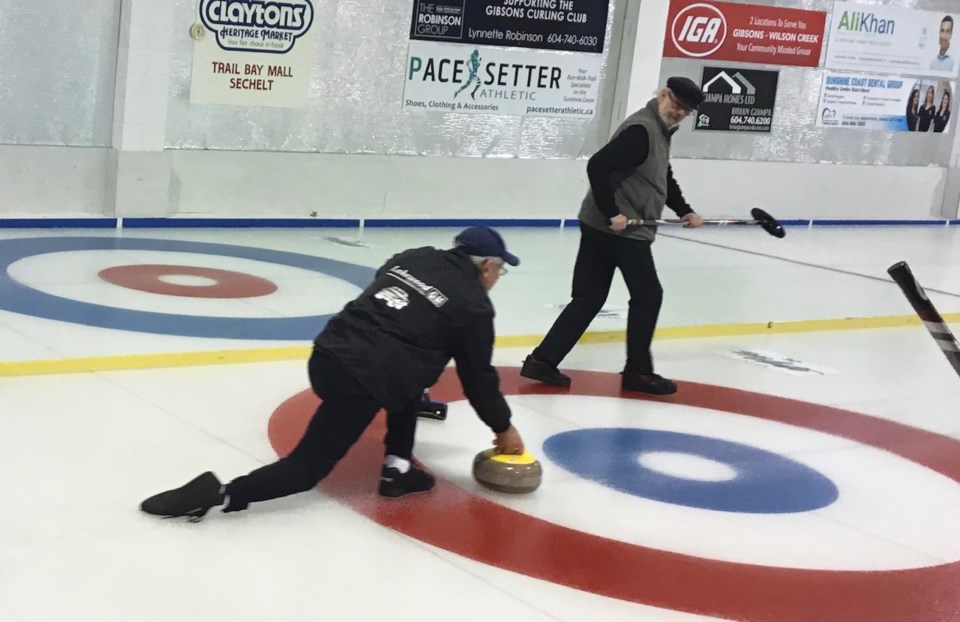This series of articles about curling wouldn’t be complete had I not consulted our senior curlers at the Gibsons Curling Club. We have curlers who were here at the very beginnings of curling on the Sunshine Coast in 1976. That’s when the Gibsons Curling Club was actually built, mostly by volunteers in the community. Some of those curlers had curled for over 20 years even before that.
Curling was a different game all those years ago. The curlers showed up in heavy wool sweaters adorned with a plethora of curling pins from clubs and competitions they’d been to or participated in. They used leather shoes as “sliders” rather than today’s synthetic Teflon and the like. In the early ’50s some of our senior curlers remember the game when the brooms looked more like the old corn straw broom you’d use in your kitchen. That was the era when, in some clubs across Canada, curlers actually brought their own personal curling rocks to the game. Imagine carrying a bag with over 80 pounds of curling rocks in it just to play your weekly game.
In those days the rocks were different than the curling stones we know today. Today, our curling stones have different coloured handles to denote the teams and they are universal in their size. In the early ’50s and before, each team had pompoms of different colours that belonged to their particular team. And the rocks weren’t necessarily all the same size. They’d simply tie their team pompoms on the handles of eight rocks, the other team doing the same with their own pompoms.
If you come into the Gibsons Curling Club you’ll note the scoreboards have a number sequence on them that goes up to 14. Most present-day curlers don’t even know that’s a throwback in curling history. In the early years, curling games were up to 14 ends long, thus the number 14 on our present-day score boards. A game in today’s world is only eight ends long. In many parts of Canada, the game was played on natural ice so your weekly game depended on the weather. With today’s game being played on treated water used for the artificial ice surface, the speed of the ice and the very “texture” of the ice is so different from all those years ago, at times it’s hard to imagine playing this exacting game on anything else.
Our Gibsons Curling Club senior curlers have gone through the broom revolutions too, from the household looking corn straw brooms of the ’40s and ’50s, to synthetic brooms, to horsehair brushes, and now to synthetic brushes. A bonspiel (the traditional name for a curling tournament) in those early years was a community event in every sense of the word. Community hotels and motels were filled with out-of-town curlers, games would start mid-week and run day and night throughout the weekend. The entire community, curlers or not, came out and partied, watched the curling and celebrated the event. In truth, some curlers seldom, if ever, left the rink for days on end. It wasn’t all curling though, if you know what I mean.
Curling has a reputation that it’s having a hard time living down. There was a time when a little alcoholic imbibement was as much a part of the game as sweeping the rock. In fact, there was a time when some broom handles even had a screw cap on the end. The broom handle was a flask. That and participating in the sport with a cigarette dangling from your mouth was typical.
The senior curlers have seen such an evolution, yet they’re still out there. Today, at the elite level, curlers are fit, dedicated athletes. Their fitness level matches that of athletes in virtually any other sports discipline. And, as a previous article in this series illustrated, our seniors can continue curling long after their aging flexibility restricts them from the traditional curling delivery. Stick curling allows seniors to keep active in the game long after other sports have forced them to sit it out.
In short, curling is a game for everyone from young to old. When I ask seniors why they’re still curling, some 60 and 70 years later, the answer is simple: “I just love the game.”
Drop in to the Gibsons Curling Club any time you’re driving by and the lights are on. The door’s usually open, and you’re welcome to watch. There’s usually someone there to answer your questions. And if it’s the senior curlers you happen to drop in on, just think of the evolution and changes they’ve seen in the game that they love so much. Curling is truly a game for the community. Maybe there’s a place for you in our wonderful game.
In my next, and final article for this season, watch for information that’ll allow you to come out and try the game. Saturday, Feb. 22 is National Curling Day. Our club will be open for you to come and watch, and even to try throwing a rock or two.



